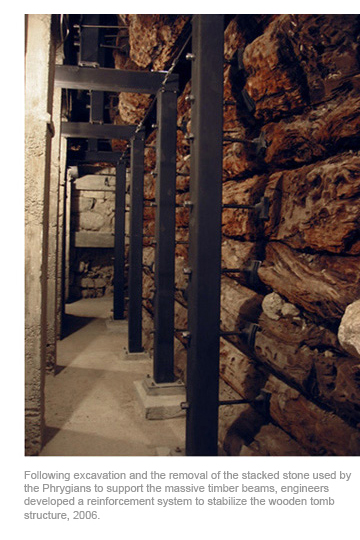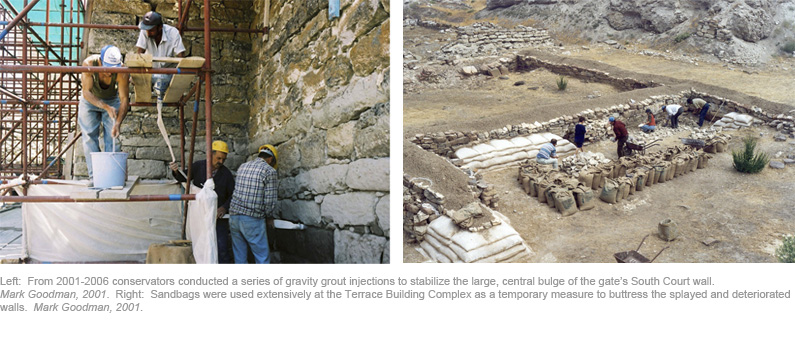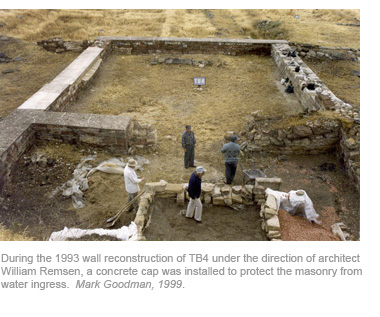 |
ACL Project List |
 |
 |
| Situated on the flat Anatolian Plateau along the Sakarya River about 100 kilometers southwest of Ankara, Gordion is immediately defined by its flat-topped settlement mound and a rolling landscape containing hundreds of surrounding tumuli. Research now confirms that the ancient Phrygian capital extended beyond its main mound; however the majority of the archaeological excavations has focused on the so-called citadel and selected tumuli. Although excavations began in 1893 and continued in 1900 by the Körte brothers, the site came into fame beginning in 1950 with Rodney S. Young of the University of Pennsylvania who began an intensive excavation and research program extending over 17 seasons until his sudden death in 1973. The current field program, begun in 1988 after a 12 year hiatus, under the co-direction of Kenneth G. Sams (University of North Carolina-Chapel Hill) and Mary Voigt (College of William and Mary), has pursued both archaeological research and much-needed site and artifact conservation in an effort to better understand and present Gordion and the ancient Phrygians to scholars and the public. |
| Click on timeline feature to launch full timeline site |
| Archaeological research at Gordion has revealed a complex settlement history extending over 3800 years from ca. 2500 BCE to the 14th century AD. Moreover, a major conflagration around 800 BCE destroyed much of the complex, already under renovation, necessitating a complete rebuilding of the citadel encapsulating the earlier buildings and fortifications under a carefully laid clay and rubble fill up to five meters thick. This destruction and the Phrygian’s response to fill and rebuild their citadel has had the fortunate effect of preserving much of the Early Phrygian plan including buildings and pavements, fortification walls, and many associated finds. Moreover the rapid destruction and subsequent filling preserved the more subtle processes of building alterations in progress just before the fire. |
| Continuous occupation of the site and reuse (i.e.,robbing) of building materials from each succeeding period combined with Young’s excavation strategy has had the combined effect of leaving a largely Early Phrygian plan now exposed, albeit partially. Like ancient Thera and Pompeii, Gordion now displays a moment in time preserved by catastrophe and by the ancient Phrygian’s response in their rebuilding program, revealed through selective modern excavation. This aspect of the site’s formation and discovery is an important factor in determining how Gordion’s citadel should be conserved and more importantly, presented and displayed. Given the fact that excavation has now ceased for the moment, a conservation plan for both the citadel and the surrounding vicinity can now take priority. |
1950-1974 Only the gate appears to have been subjected to minor reconstruction when during its excavation in 1955, the northwest ramp wall of the north court and the top of the southwest ramp wall of the south court were rebuilt with stone blocks recycled during the Middle Phrygian period in the construction of the later “dam wall” (bottom center). In 1961 an important pebble mosaic--the earliest of its type--from megaron 2 was cut and lifted in panels and transported to the Gordion Museum where it was later re-installed under shelter outdoors (bottom right).
|
 |
 |
1978 - 1987 After Rodney Young’s death in 1974, excavation at Gordion ceased until 1988. Nevertheless during that time period, several site conservation initiatives were begun to try to halt the cumulative damage resulting from abandoned trenches and unsupported baulks. It was also during this time that attempts were initiated to monitor perceived structural problems at the gate complex and tumulus MM. |
|
1988 -present |
In 2002 low-pressure gravity grouting was begun on the dry laid masonry gate. For the terrace buildings, an elaborate system of sandbag buttressing and soil capping of the splayed walls was begun earlier at TB1, 2, and 8 and later extended to the entire building and other masonry features. The tragic death of Goodman in 2004, brought the Architectural Conservation Laboratory of the University of Pennsylvania (ACL-UPenn) to the site and together with Middle East Technical University (METU), a comprehensive conservation and management program for the citadel and region is now underway. |
 |
